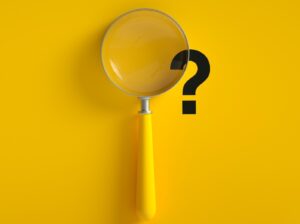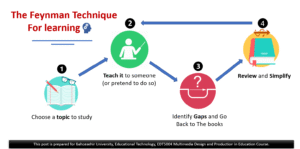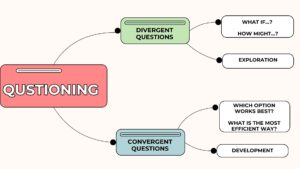Unlocking Deeper Understanding Through Thoughtful Inquiry
Human progress has always ridden on the back of questions. From “What’s beyond the horizon?” to “What happens if we split this atom?”, every leap has begun with someone brave enough or curious enough to ask.
Plenty of blogs talk abo ut why questions matter and here’s my take: a scientific yet simple exploration of the art of questioning as a skill, a tool and even an art form. Let’s explore the lesser-discussed dimensions of inquiry that can sharpen your thinking, deepen your relationships and fuel innovation.
ut why questions matter and here’s my take: a scientific yet simple exploration of the art of questioning as a skill, a tool and even an art form. Let’s explore the lesser-discussed dimensions of inquiry that can sharpen your thinking, deepen your relationships and fuel innovation.
The Neuroscience of Curiosity
Curiosity is neural. When we ask questions, our brain’s dopaminergic pathways light up, releasing reward chemicals that keep us engaged and motivated. In simple terms, every question is like striking a match in the dark: it ignites learning and primes us to seek answers.
This is how we are wired. Questioning isn’t a quirk of children; it’s a survival tool baked into human biology.
 Try the “Curiosity Walk.” Step outside and pick an everyday object you normally ignore. Write down five questions about it. You will be surprised how quickly your brain switches on.
Try the “Curiosity Walk.” Step outside and pick an everyday object you normally ignore. Write down five questions about it. You will be surprised how quickly your brain switches on.
In our Train the Trainer programs, we see this play out in real time. One participant might know their subject inside-out, but when asked to explain it, their explanation flies so high over the audience’s head that no one gets it. That’s when we challenge them: “Can you explain this as if your 12-year-old nephew asked you?” The magic happens the moment they drop jargon, simplify and start questioning their own assumptions about what the audience knows.
Use the Feynman Technique: whenever you learn something, ask “Why does this work?” and try explaining it to a child. Your brain rewards the search for clarity.
The Feynman Technique
The Feynman Technique is a powerful method for mastering complex ideas by teaching them simply. Named after Nobel Prize–winning physicist Richard Feynman, it breaks learning into four steps:
- Choose a concept – Pick what you want to learn.
- Teach it simply – Explain it as if you’re teaching a 12-year-old. Use plain language, no jargon.
- Find the gaps – Wherever you stumble or get fuzzy, that’s where your understanding is weak.
- Review and simplify – Revisit the source material, then refine your explanation until it’s crystal clear.
The magic lies in simplicity: if you can’t explain it clearly, you don’t fully understand it. This tool forces depth, clarity and true mastery.
In communication training, we sometimes give one participant a picture and ask them to describe it so others can sketch it—without ever seeing the original. Every misplaced word or unclear instruction shows up instantly on the paper. It’s questioning in disguise: “What’s the simplest way I can say this so that others truly get it?”
Questioning as a Cognitive Skill: Beyond “Why”
Why?” is a powerful question, but it is only one part of the picture. Questioning is like exercise for the brain and it works in two different ways:
- Divergent questions (“What if…?” “How might…?”) spark imagination and open up new ideas.
 They help you look at situations from different angles and come up with creative possibilities that you may not have thought of before.
They help you look at situations from different angles and come up with creative possibilities that you may not have thought of before. - Convergent questions (“Which option works best?” “What is the most efficient way?”) help narrow down choices and focus on what is practical. They are about weighing options, making comparisons and deciding on the best path forward.
The real power lies not in the number of questions but in the variety. Some expand your thinking, while others bring focus. Together, they give you both big ideas and clear decisions.
We use this distinction when working with teams under pressure. A sales team, for example, might brainstorm with divergent questions about how to reach new clients, then switch gears to convergent ones: “Given our budget, which option gives us the quickest ROI?” Knowing which kind of question to ask saves time, energy and frustration.
The Silent Power of Non-Verbal Questions
Not every question is spoken out loud. Sometimes silence and body language do the asking:
A raised eyebrow can quietly say, “Really?” and make someone explain more.
A long pause can signal, “Go on…” and give space for deeper sharing.
A thoughtful silence can invite the other person to reflect and fill the gap with what matters most.
These non-verbal cues can be even stronger than words. They subtly encourage exploration without the pressure of direct interrogation. Few people talk about this, but silence used well often asks louder questions than speech.
We had a leader in one of our training session who said very little. Instead, he leaned forward, nodded and held the silence. His team member, initially hesitant, eventually opened up with, “Okay, let me tell you what’s really going on…” The silence asked the question words never could.
Questioning in the Age of Information Overload
We live in a world where information is everywhere, but clear understanding is hard to find. The risk is mental overload.
This is where triage questioning helps—a way to filter what really matters:
- What is essential to know right now?
- What can wait until later?
- What is just noise I can ignore?
Just like an emergency doctor sorts the critical from the non-critical patients, your questions must do the same. They help you focus on what is useful and urgent, instead of getting lost in endless data and distractions. Without this filter, curiosity gets drowned in chaos.
This is particularly useful in corporate settings where emails, Slack messages and meetings compete for attention. Teams that consciously ask, “Does this really need my focus right now?” perform sharper and burn out less.
Questions as Catalysts for Empathy and Connection
Questions do more than bring out information—they bring out people. A genuine question sends a message: I see you. I care about your perspective.
When used with care, questions can:
Bridge gaps across cultures, ages or backgrounds.
Ease conflict by softening rigid positions and opening space for dialogue.
Build safety so people feel free to share honestly without fear.
In short, questioning is one of the simplest yet most profound empathy tools we have.
We have seen this in cross-cultural leadership workshops in the GCC. A simple “How would this work in your context?” transforms the room. Suddenly participants from cultural backgrounds are sharing perspectives and learning from each other. One good question dissolves borders better than a stack of PowerPoint slides.
Designing Unanswerable Questions: Fuel for Innovation
Sometimes the best questions aren’t meant to be answered (at least not immediately). Some of the most powerful ones are unanswerable at first. They stretch thinking, open new perspectives and create space for fresh ideas.
Think of questions like:
- “What problem does not exist yet, but might in five years?”
- “If resources were unlimited, what would we try?”
These questions are about stretching imagination until something new emerges.
Take the sudden rise of generative AI. Five years ago, most teams weren’t asking, “How could AI co-create with us in marketing, design, or even coaching?” Today, those who dared to explore that “unanswerable” question are reshaping entire industries.
Practical Takeaways: Cultivating the Art of Questioning
So how can you actually get better at asking questions? Here are a few easy practices to try:
- Daily Curiosity Diary: Write down three questions that came to you during the day. You do not need answers, just noticing them builds the habit of inquiry.
- Reflective Pauses in Conversation: Before jumping in to reply, pause for a moment. Silence often invites deeper and more thoughtful responses.
- Question-Only Brainstorming: In a group session, ban statements and allow only questions. The energy rises, and creativity flows in surprising directions.
- Information Triage: Use the three triage questions:
What matters now? What can wait? What can I ignore?
They will help you cut through the noise and protect your mental energy.
Small shifts like these, practiced regularly, can turn questioning from a skill into a mindset.
Conclusion: The Transformative Power of Questions
At its core, questioning is both science and art. It’s a biological imperative, a cognitive skill and a human bridge. It fuels learning, sharpens focus, deepens empathy and sparks innovation.
So next time you catch yourself asking a question, pause and notice. You are not just filling a gap in knowledge, you are engaging in one of the most powerful acts of being human.
“In mastering the art of questioning, we master the art of learning, connecting, and creating.”
To know more about how The Yellow Spot can help you on your Learning journey, Visit ‘https://www.theyellowspot.com’ for more info or reach out at info@theyellowspot.com / India: +91 99677 14310, +91 87792 84314





